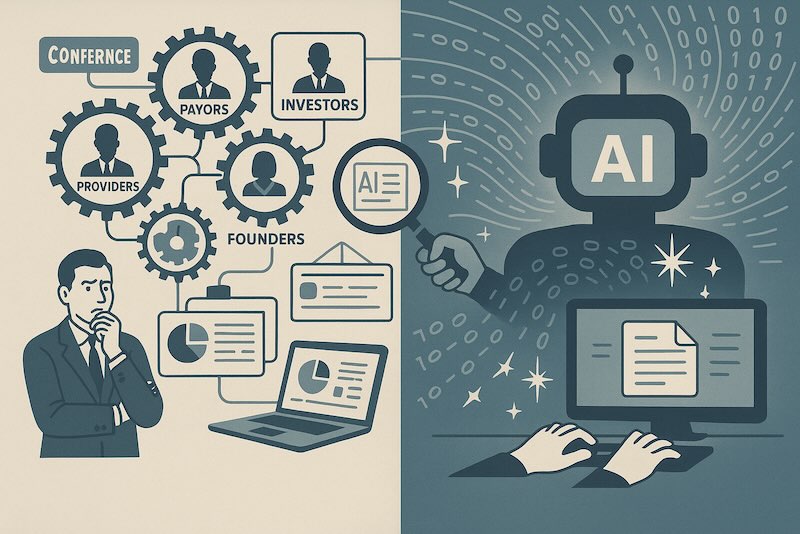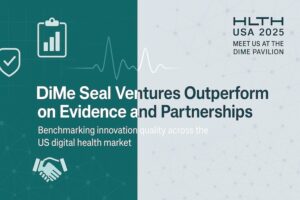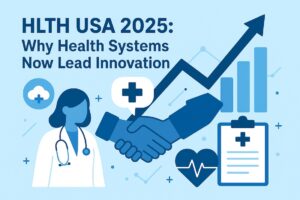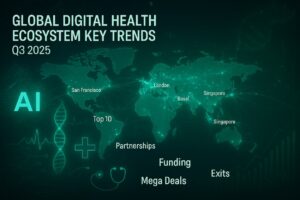Why the Ecosystem Must Reinvent Itself—Fast—in the Age of AI
Digital health has been a vibrant and well-funded space for over a decade. Yet, the machinery that connects its stakeholders—pharma scouts, investors, health-system buyers, and founders—still looks remarkably old-school. Most discovery occurs through trawling conferences, Googling “top digital health startups”, “digital health transformation”, or skimming pitch decks—the same playbook innovators have relied on for decades. Even big-pharma executives concede that “no pharma has yet completely cracked the code for how to leverage best and operationalise digital health.”
At the same time, we have entered an era where AI is upending every information flow. Generative tools can scan millions of documents in minutes, draft diligence memos in seconds, and also spin up convincing fictions just as fast. Those who modernise their sourcing and evaluation processes stand to win; those who stay conventional risk irrelevance.
Below are the critical pain points holding the ecosystem back, how AI both aggravates and solves them, and a pragmatic path forward that keeps humans—and evidence—in the loop.
The Stakeholder Connection Problem
Finding the right match is still a painstakingly manual process.
- Pharma vs. Startups. The top 25 biopharma companies account for 10% of global digital-health partnerships, yet the scouting process remains slow and opaque. Nearly three-quarters of the ventures they do engage already brandish AI, showing how fast the bar is rising even as matchmaking lags.
- Investors vs. Deal Flow. Seasoned VCs admit they screen hundreds of decks to uncover one gem; the funnel is relationship- and location-biased, favouring insiders and repeat founders.
- Health-systems vs. Solutions. Providers account for 20+% of partnerships in Digital Health. The CIOs still rely on vendor fairs and warm intros, meaning many clinically strong but network-poor startups never get a first meeting.
Why it matters
A reactive, conference-driven funnel lets breakthrough ideas languish while better-connected but weaker solutions advance. The opportunity cost—unmet patient needs, wasted capital, stalled adoption—is enormous.
Bias and Blind Spots
Even when stakeholders are looking, structural bias distorts what they see.
- SEO & Algorithmic Bias. Search engines now surface AI-generated summaries (“AI Overviews”) that siphon clicks away from source sites and amplify content that is already optimised for the algorithm, rather than the most rigorous science. Publishers have seen referral traffic drop by 30–35% since AI summaries were rolled out.
- Network Bias. Operating partners and senior investors naturally rely on familiar circles; that imperative to network reinforces age, geography, and alma mater bias in deal sourcing.
- Echo-Chamber Pitching. Founders polish their decks for what they think VCs want to hear, leading to herd-like positioning and missed white space.
The consequence: great science with poor SEO or weak networks remains invisible, while well-packaged mediocrity rises to the top.
The Double-Edged Sword of AI
AI is simultaneously both the polluter and the purifier of digital health knowledge.
| Risk | Evidence |
| Content Pollution – “AI slop” floods the web with low-value, machine-generated posts, making it harder to trust what you read. | Experts warn the internet is “being choked by a rising tide of low-quality, machine-generated content.” |
| Hallucinations – Large language models fabricate plausible but false facts, as seen when Google’s AI told users to eat a rock a day. | BizTech documents the reputational and legal risks of LLM hallucinations for enterprises. |
If scouts swap Google for a shiny Gen-AI copilot without guardrails, they trade one bottleneck for another—speeding up searches but also propagating fiction at light velocity.
A Blueprint for an Evidence-First, AI-Augmented Future
- Adopt AI for Exhaustive Discovery, Not Final Decisions
Deploy tools that map the entire venture universe—academic spinouts, stealth startups, small-market solutions—by crawling publications, patents, and registries 24/7. Then push short-listed leads to humans who understand clinical workflows and regulatory nuance.
- Install Bias Filters & Explainability Layers
Retrieval-augmented generation (RAG) and provenance tracking can force models to cite primary evidence, flag low-authority sources, and surface contrarian outliers.
- Keep a Human-in-the-Loop (HITL)
Peer-review-style expert panels, equipped with domain knowledge, must vet model outputs before strategy or capital decisions are made. HITL workflows “ensure accuracy and minimise errors,” especially when decisions affect patient safety.
- Partner with Specialist Research Firms
The ideal scenario is a research partner that combines state-of-the-art AI infrastructure with analysts who can track down missing data and perform sensitivity checks. Academic commentary in JAMIA emphasises that keeping the human in the loop is non-negotiable for ensuring safe and equitable AI in healthcare.
- Measure What Matters
Replace vanity metrics (impressions, deck count) with signal-rich KPIs e.g. evidence levels.
The Call to Action
Digital health is too mature—and the AI era too unforgiving—for business as usual. The next wave of winners will:
- Automate the grunt work of horizon scanning so that human talent can spend time on value-added strategy, not inbox triage.
- Debias the top of the funnel by looking beyond SEO rankings and founder Rolodexes.
- Validate relentlessly through HITL research partners who can distinguish between robust evidence and synthetic noise.
- Act now, before bolder competitors—and the patients they serve—leave them behind.
Yes, the ecosystem faces a credibility crisis born of information overload and algorithmic distortion. However, the same AI tools that created the mess, when paired with disciplined human oversight, can transform fragmentation into focus and noise into actionable insights.
The choice is stark: Refactor your innovation engine today or watch more agile neighbours capture tomorrow’s value. Digital health solved what, ground-breaking products? It’s time to solve the how: an evidence-first, AI-augmented, human-verified pathway from idea to impact.








